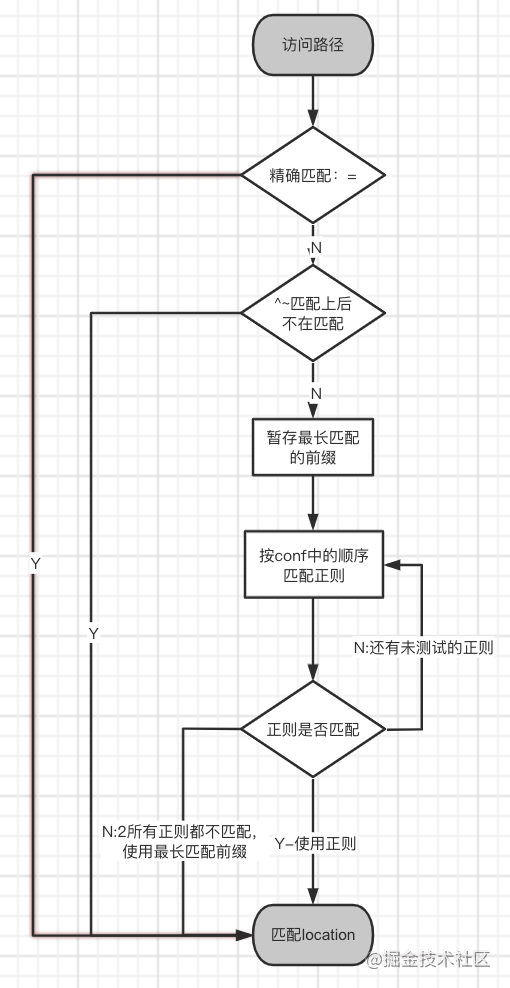教你nginx跳轉配置的四種方式
前言
最近工作用到瞭nginx,但是路由配置特殊,業務場景復雜,因此整理瞭集中nginx跳轉的配置方式,如servername的正則,location的匹配順序,rewrite和proxy的示例,相信總有一種滿足你的需求。
一、配置server對應的域名
server name 為虛擬服務器的識別路徑。因此不同的域名會通過請求頭中的HOST字段,匹配到特定的server塊,轉發到對應的應用服務器中去。server_name匹配規則:後面可以跟多個域名,第1個是主域名
1.1、精確匹配
如下nginx配置
listen 8080;
server_name test1.com;
location / {
return 200 "I am test1!\n";
}
}
server {
listen 8080;
server_name my.test.com;
location / {
return 200 "I am mytest!\n";
}
}
請求結果
curl http://my.test.com:8080 返回:I am mytest!
curl http://test1.com:8080 返回:I am test1!
1.2、正則表達式
以*通配符開始的最長字符串,如下示例
server {
listen 8080;
server_name test1.*;
location / {
return 200 "I am test1!\n";
}
}
以*通配符結束的最長字符串
listen 8080;
server_name *.test.com;
location / {
return 200 "I am mytest!\n";
}
}
通配符名字隻可以在名字的起始處或結尾處包含一個星號,並且星號與其他字符之間用點分隔。所以,“my..com“都是非法的。
例如 :server_name my..com;
報以下錯誤:
nginx: [emerg] invalid server name or wildcard "my.*.com" on 0.0.0.0:8080
匹配正則表達式
server {
listen 8080;
server_name ~^my(?<serno>.+).mydomain.com$;
location / {
return 200 $serno;
}
}
解釋說明
- ~: 表示大小寫敏感的正則;
- ^:匹配字符串的開始;
- {.+}:換行符以外的任意自讀重復一次活更多次;
- (): 分組與取值;
- :表示轉義;
- serno:設置提取的變量;
- $:匹配字符串的結束;
請求結果
curl http://my02.mydomain.com:8080 返回:02% curl http://my03.mydomain.com:8080 返回:03%
server_name的配置順序是怎樣的呢?
按照如下順序匹配:
- 匹配順序->
- ->精確匹配
- ->*在前的域名
- ->*在後的域名
- ->按文件中的順序匹配
- ->default server:第一個,listen指定default
二、配置location
2.1、Location 匹配規則:僅匹配URI,忽略參數
location [=|~|~*|^~] /uri/ { … }
匹配的正則符號如下:
- = 嚴格匹配。如果請求匹配這個location,那麼將停止搜索並立即處理此請求
- ~ 區分大小寫匹配(可用正則表達式)
- ~* 不區分大小寫匹配(可用正則表達式)
- !~ 區分大小寫不匹配
- !~* 不區分大小寫不匹配
- ^~ 如果把這個前綴用於一個常規字符串,那麼告訴nginx 如果路徑匹配那麼不測試正則表達式
2.2、舉例
1、匹配任意請求
location [=|~|~*|^~] /uri/ { … }
2、不區分大小寫匹配以js、php結尾的請求
location ~* .(js|php)$ { … }
3、區分大小寫匹配以.txt結尾的請求
location ~ ^.+\.txt$
2.3、匹配順序如下圖

按照上面的規則配置瞭如下location
location = /documents {
return 200 'configuration A'
}
location /documents {
return 200 'configuration B'
}
location /documents/txt1 {
return 200 'configuration C'
}
location ^~ /documents/ {
return 200 'configuration D'
}
location ~* /documents/(\w+)$ {
return 200 'configuration E'
}
location ~ /documents/$ {
return 200 'configuration F'
}
- curl http://test1.com:8080/documents,精確匹配返回 configuration A
- curl http://test1.com:8080/documents/ ^~匹配上後不在匹配,返回 configuration D
- curl http://test1.com:8080/documents/txt1 走到瞭正則匹配,不會走到/documents/txt1(正則沒走完) 返回configuration E
- curl http://test1.com:8080/documents/txt1/,返回configuration C,因為正則都不匹配
2.4、如何debug正則呢?
編譯的時候加上 –with-debug選項,例如 ./configure –with-debug
conf文件加上要debug的host,debug_connection對應要debug的連接。
events {
worker_connections 1024;
debug_connection 192.168.1.3;
debug_connection 127.0.0.1;
}
error.log查看debug日志,圖中test location就是正則匹配的過程

三、配置rewrite
語法如下:
指令語法:rewrite regex replacement[flag];
默認值:none
應用位置:server、location、if
rewrite是實現URL重定向的重要指令,他根據regex(正則表達式)來匹配內容跳轉到replacement,結尾是flag標記.
| flag標記 | 說明 |
|---|---|
| last | 本條規則匹配完成後繼續向下匹配新的location URI規則 |
| break | 本條規則匹配完成後終止,不在匹配任務規則 |
| redirect | 返回302臨時重定向 |
| permanent | 返回301永久重定向 |
3.1、重定向
return三種code,code url和url。
返回狀態碼:444表示關閉連接 301表示http1。0中永久重定向,302表示臨時重定向,進制緩存。http1.1後,303表示臨時重定向,允許改變方法,進制緩存,307表示臨時重定向,不允許改變方法,禁止被緩存,308表示永久重定向,不允許改變方法。
返回code
location / {
return 301 https://www.xxxx.com$request_uri;
}
通過$request_uri變量匹配所有的URI。
rewrite ^ https://www.xxxx.com$request_uri? permanent;
通過正則匹配所有的URI後再去掉開頭第一個/(反斜線)。
rewrite ^/(.*)$ https://www.xxxx.com/$1;
與if指令結合
server {
listen 80;
server_name test1.net test2.net;
if ($host != 'test1.net' ) {
rewrite ^/(.*)$ http://www.baidu.net/$1 permanent;
}
}
3.2、如何查看rewrite日志
打開日志開關rewrite_log on;
可以配置到http,server,location和if上下文中
示例:curl http://test1.com:8080/first/2.txt
location /first {
rewrite_log on;
rewrite /first(.*) /second$1 last;
}
效果圖如下

四、配置 proxy
對上遊服務使用http/https協議進行反向代理。proxy_pass後面跟url,可以仿造location,if in location和limit_except上下文中。 這個功能是默認編譯到nginx中的。本文重點討論http proxy。
url參數規則
- url必須以http或者https開頭,接下來是域名、ip、unix socket或者upstream名字,都可以就端口。後面是可選的uri
http示例
proxy_pass http://localhost:8000/uri/;
UNIX域套接字路徑來定義示例
proxy_pass http://unix:/tmp/backend.socket:/uri/;
url中是否攜帶uri,結果也不一樣,如果在proxy_pass後面的url加/,相當於是絕對根路徑,則nginx不會把location中匹配的路徑部分代理走;如果沒有/,則會把匹配的路徑部分給代理走。
目錄結構如下
├── first
│ └── index.html
├── index.html
└── second
└── index.html
nginx配置如下
server {
listen 8081;
server_name my.test.com;
}
server {
listen 8082;
# 第一種情況
location /first {
proxy_pass http://my.test.com:8081;
proxy_set_header Host $host;
proxy_set_header X-Real-IP $remote_addr;
proxy_set_header X-Forwarded-For $proxy_add_x_forwarded_for;
}
# 第二種情況
location /first {
proxy_pass http://my.test.com:8081/;
proxy_set_header Host $host;
proxy_set_header X-Real-IP $remote_addr;
proxy_set_header X-Forwarded-For $proxy_add_x_forwarded_for;
}
}
不帶/,然後 curl http://127.0.0.1:8082/first/index.html 返回index html
帶/,然後 curl http://127.0.0.1:8082/first/index.html 返回first index
- Url參數中可以攜帶變量
proxy_pass http://$host$uri; - 可以配合rewrite break語句
location /nameb/ {
rewrite /nameb/([^/]+) /test?nameb=$1 break;
proxy_pass http://127.0.0.1:8801/;
}
五、小結
配置nginx的路由,有多種方式,域名可以用server_name配置,uri可以用location配置,復雜的可以加rewrite配置修改請求。還有就是配置proxy代理,在代理中轉發id等。
到此這篇關於nginx跳轉配置的四種方式的文章就介紹到這瞭,更多相關nginx跳轉配置內容請搜索WalkonNet以前的文章或繼續瀏覽下面的相關文章希望大傢以後多多支持WalkonNet!
推薦閱讀:
- Nginx的rewrite模塊詳解
- Nginx 負載均衡是什麼以及該如何配置
- nginx中的兩個模塊的proxy_pass的區別解析
- 詳解前端到底可以用nginx做什麼
- Nginx反向代理入門實戰指南